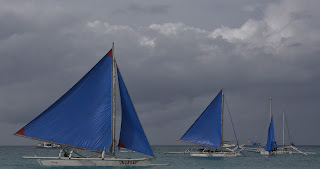Friday, January 20, 2012
The Philippines: Transportation Tales
For any kind of traveling, transportation options tend to play key roles in shaping the adventure. For the Philippines, though, options for transport not only helped shape the adventure but they fascinated me daily throughout our visit, sustaining key positions in both my consciousness and imagination.
Geographically speaking, the Philippines is an archipelago comprised of over 7,000 islands, and “small” would describe the majority of them. Largely volcanic in origin, many of these islands are hilly, even mountainous (to include several active volcanos), and swathed in the dense luxuriance of tropical rainforest. Hence, a developed highway system is impractical—and virtually nonexistent on many of the islands—beyond Manila and environs and a handful of other urban centers. [In truth, Manila most certainly holds a superior ranking for cities of the planet with optimal traffic gridlock, but we were only there to make our entrance and our exit—probably not even 48 hours in total—so everything remained somewhat novel, another amazing facet of the overall adventure . . . even the traffic! Besides, in Manila, I witnessed the infamous “jeepneys” in action, though, sadly, I never had the chance to ride in one!]
Planes and boats are modes of transportation required for island hopping. A boat will suffice for the entire process, but often a plane will not. Except for flying in or out of Manila (located on Luzon, the largest island), any change of island for us necessitated the use of both modes in combination with some vehicle shuttling between “staging grounds”—usually a van. We learned early that airlines transporting passengers and supplies between islands in the Philippines employed fleets of smaller planes, usually props, for important reasons: Small islands plus little to nil natural flat land equals short runways! Then, of course, other than Manila, we never actually spent our days and nights on islands large enough to accommodate any sort of runway, so we always had at least one boat in the transportation mix as well.
Island Hop: Manila to Busuanga (and later, to Sangat Island Dive Resort)--descent into Busuanga
As soon as we touched down in this plane at Busuanga, the pilot began braking hard. Both landing and take-off required the full length of the runway; there was no place--or even space--for an "oopsie." Located rather far from the town (relatively speaking, of course, because Busuanga is not a big island) the airport, Tammy and I decided, had to be built in a place flat enough and long enough for a runway, a kind of space in short supply on this island!
Island Hop: Boracay to Manila - boat from Boracay to the port near Caticlan (island of Panay, where there is an airport, two in fact--Caticlan and Kalibo) and the tidal depth would not allow the boat to anchor closer to the beach, so the passengers--including Tammy and me--were transported from boat to beach as pictured here. (This lady was a fellow passenger!)
Tricycle--the "Philippine taxi"
Tricycle queue near Puka Beach on Boracay
Once ensconced on an island, we transported ourselves by foot for the most part. Flip-flops ranked second only to "bare" for footwear, and some afternoons even now the toes on my left foot still rebel against their current shod condition. Here is Tammy heading along Puka Beach in search of our place to situate for a few hours.
Boats—okay, and motorcycles—are my favorite modes of transportation. Yes, I realize that for many situations and circumstances they might be impractical, even impossible, but they appeal to my nature and converse with my imagination. One thing I especially loved about the Philippines is that it is rife with boats . . . all kinds of boats.
Our last full day on the island of Boracay, Tammy and I hired a sailboat, the Nino, to take us from White Beach, the location of our hotel, to Puka Beach, a beach at the northern tip of the island. What an incredible ride! Our "boat boys" directed us to sit on a mesh netting stretched tightly between the hull and the bamboo outriggers. For most of the trip we sat on the right side, spaced to balance with the wind and sea conditions. Before changing direction to head into Puka Beach, the boys had us crawl across the mesh to the opposite side.
Our boat boys head back to White Beach after dropping us off on Puka Beach.
I photographed boats everyday we spent in Boracay, and I would dream of sailing a one-man outrigger in a tropical sea. Here are some boats to dream on . . .
Subscribe to:
Post Comments (Atom)














































No comments:
Post a Comment